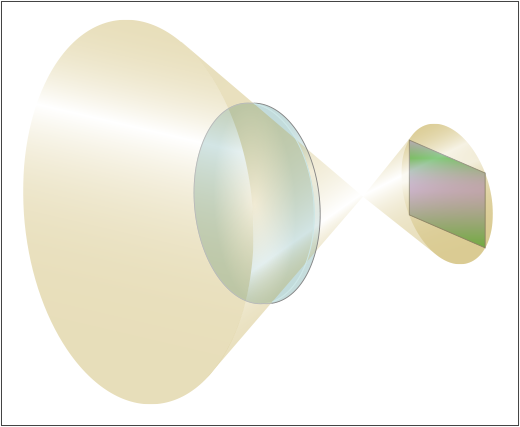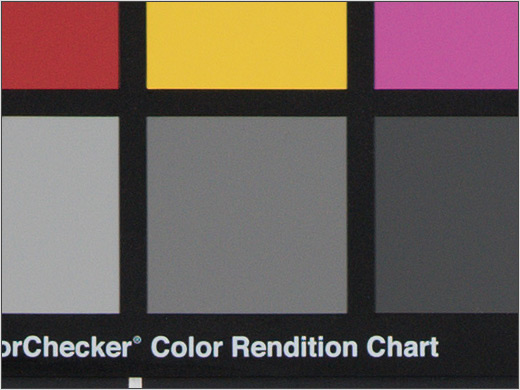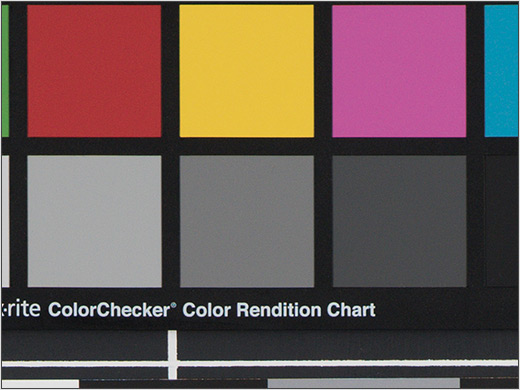Total light, smaller sensors and crops
The total amount of light that goes to make up your image is the most important factor in determining image quality.
As I tried to explain (and demonstrate) in my article on equivalence, f-numbers dictate the light intensity of an exposure (light per unit area). However, this ignores the sensor size. To understand how much total light is available to make up your image, you need to multiply this light per unit area by the area of your sensor.
Why do you say a smaller sensor sees less light?
This diagram represents the light being projected by a full frame lens onto a full frame sensor. The second image shows what happens when you mount that same lens on an APS-C sensor: the smaller sensor can only see the inner, bronze-colored cone of light, the rest of the original yellow cone of light is no longer available for capture.
It’s not condensed down onto the smaller sensor (if it were, then you’d still get the same field-of-view), it’s just lost.
 |
|
| 1) Full Frame lens on Full Frame Sensor | 2) Full Frame lens on APS-C sensor |
| 3) APS-C-specific lens on APS-C sensor | 4) Full frame lens giving the same field-of-view as the APS-C sensor sees (The ‘equivalent’ lens) |
What about APS-C-specific lenses? Well those simply never project the extra, outer cone of light. This means they can be smaller, but they still don’t get access to that extra light.
Prove it!
The assertion that a smaller sensor sees less light and is, therefore, noisier (since it receives less light, and hence has a worse signal-to-noise ratio because of shot noise), is contentious. This is understandable, as it means thinking in terms of the whole image, not the light intensity per unit area that underpins the f-number/ISO system of exposure (that is specifically designed to work independently of sensor size).
However, while it may seem heretical to anyone strongly attached to the conventional exposure model, it is, nonetheless, demonstrably true.*
What about taking an APS-C crop image on a full frame camera? Surely that’ll have the same noise as an APS-C camera would, so how can you say the full frame image has less noise?
Let’s see, shall we?
Below are our standard studio test shots from the Nikon D810 and the Nikon D7000. These two cameras were chosen because they have different sensor sizes but very, very similar pixel sizes**. Then, in addition to this, we’ve shot the D810 in crop mode using the same lens as was used on the D7000.
When compared at 1:1 level, these crops from the images show exactly the result you might expect:
 |
||
| ISO 200 | ||
| D810 whole frame [Raw File] | D810 APS-C crop [Raw File] | D7000 [Raw File] |
| ISO 400 | ||
| D810 whole frame [Raw File] | D810 APS-C crop [Raw File] | D7000 [Raw File] |
| ISO 800 | ||
| D810 whole frame [Raw File] | D810 APS-C crop [Raw File] | D7000 [Raw File] |
| ISO 1600 | ||
| D810 whole frame [Raw File] | D810 APS-C crop [Raw File] | D7000 [Raw File] |
| ISO 3200 | ||
| D810 whole frame [Raw File] | D810 APS-C crop [Raw File] | D7000 [Raw File] |
| ISO 6400 | ||
| D810 whole frame [Raw File] | D810 APS-C crop [Raw File] | D7000 [Raw File] |
| ISO 12800 | ||
| D810 whole frame [Raw File] | D810 APS-C crop [Raw File] | D7000 [Raw File] |
All these shots were taken with the at the same F-number and shutter speed for each ISO, so experienced the same intensity of light. And, since their pixels are very similar in size and they feature similar technology, the pixel-level performance is essentially identical across all three cameras.
However, if you make the (I believe) reasonable assumption that most people won’t insist on viewing or printing their images in proportion to the sensor size they were shot with, then it becomes relevant to try viewing the images at a common output size (16MP).
 |
||
| ISO 200 | ||
| D810 whole frame [Raw File] | D810 APS-C crop [Raw File] | D7000 [Raw File] |
| ISO 400 | ||
| D810 whole frame [Raw File] | D810 APS-C crop [Raw File] | D7000 [Raw File] |
| ISO 800 | ||
| D810 whole frame [Raw File] | D810 APS-C crop [Raw File] | D7000 [Raw File] |
| ISO 1600 | ||
| D810 whole frame [Raw File] | D810 APS-C crop [Raw File] | D7000 [Raw File] |
| ISO 3200 | ||
| D810 whole frame [Raw File] | D810 APS-C crop [Raw File] | D7000 [Raw File] |
| ISO 6400 | ||
| D810 whole frame [Raw File] | D810 APS-C crop [Raw File] | D7000 [Raw File] |
| ISO 12800 | ||
| D810 whole frame [Raw File] | D810 APS-C crop [Raw File] | D7000 [Raw File] |
Now we see the effect of all the extra light captured – the outer cone in the diagram at the top of the page. The APS-C camera and APS-C crop still look the same but the extra sensor area (all exposed to the same light intensity) allows the full frame image look better overall.
Note that the full frame sensor performs better than the APS-C sensor, even though its pixels are not bigger. If you were to take full frame camera with the same pixel count as the APS-C one (and so have bigger pixels), the result would still be very similar indeed. I’ll cover the reason for this in part 2 of the sources of noise series, but the key lessons is that it’s not pixel size that makes large sensor cameras’ images cleaner (any difference from pixel size tends to occur only in shadow regions and very high ISOs), it’s the sensor size.
*To be clear, I’m not advocating abandoning the current ISO-based exposure model (though there are strong arguments for why that would make sense). Instead, I’m suggesting putting it to one side for a moment to consider the factors that it ends up masking. Looking at exposure in terms of ‘total light’ gives a clearer picture of why large sensors perform better (and it’s not larger pixels). [Jump back to text]
**The Sony IMX071 used in the D7000 has 4.8µm pixels, while the IMX094 that is very likely to feature in the D810 has 4.88µm pixels (less than a 2% difference). [Jump back to text]




 Started out doing photography at the age of 6 using an uncle's old 1940 kodak brownie box camera. At 15 years of age, I decided to buy my very own 1975 Praktica SLR camera. I now shoot with a Nikon D850. I do unpaid TFP and commercial paid work.
Started out doing photography at the age of 6 using an uncle's old 1940 kodak brownie box camera. At 15 years of age, I decided to buy my very own 1975 Praktica SLR camera. I now shoot with a Nikon D850. I do unpaid TFP and commercial paid work.